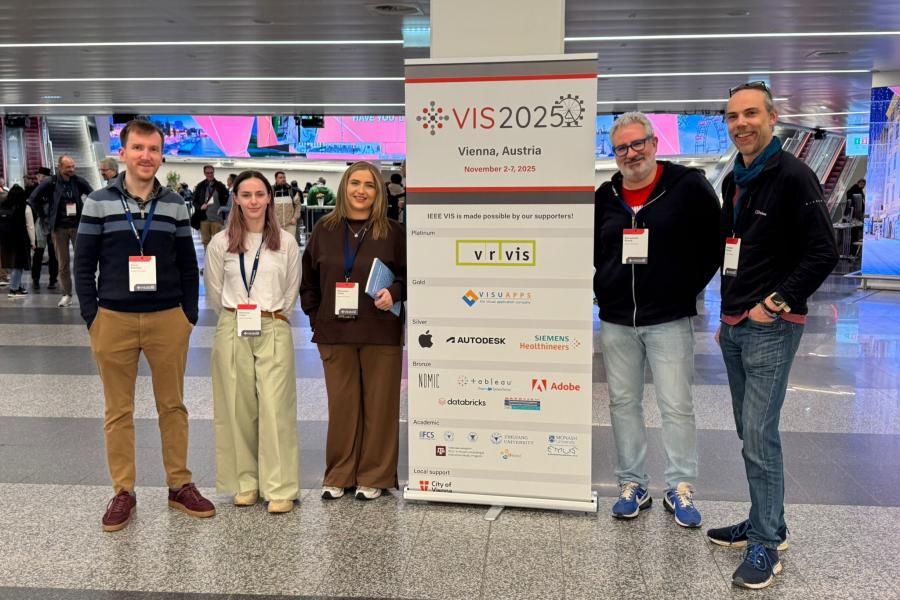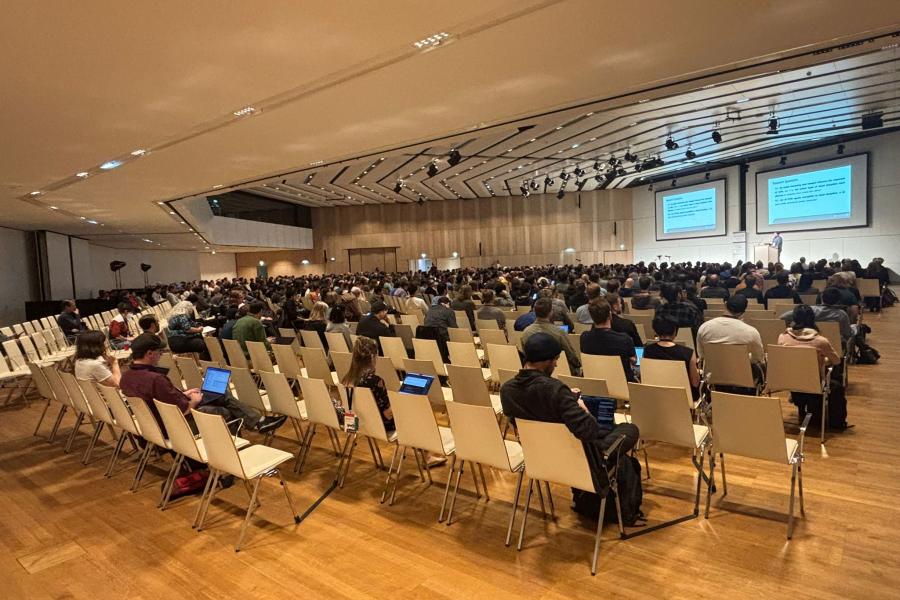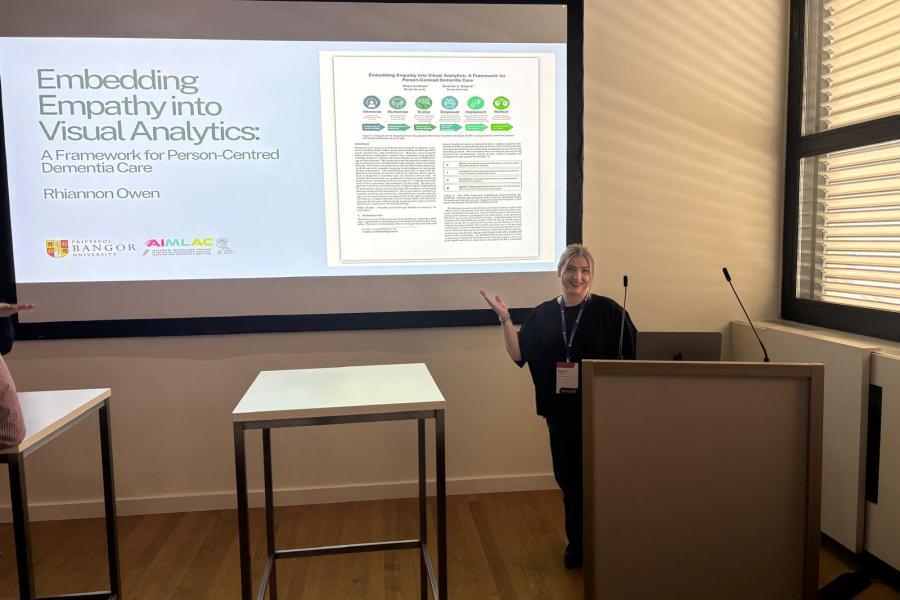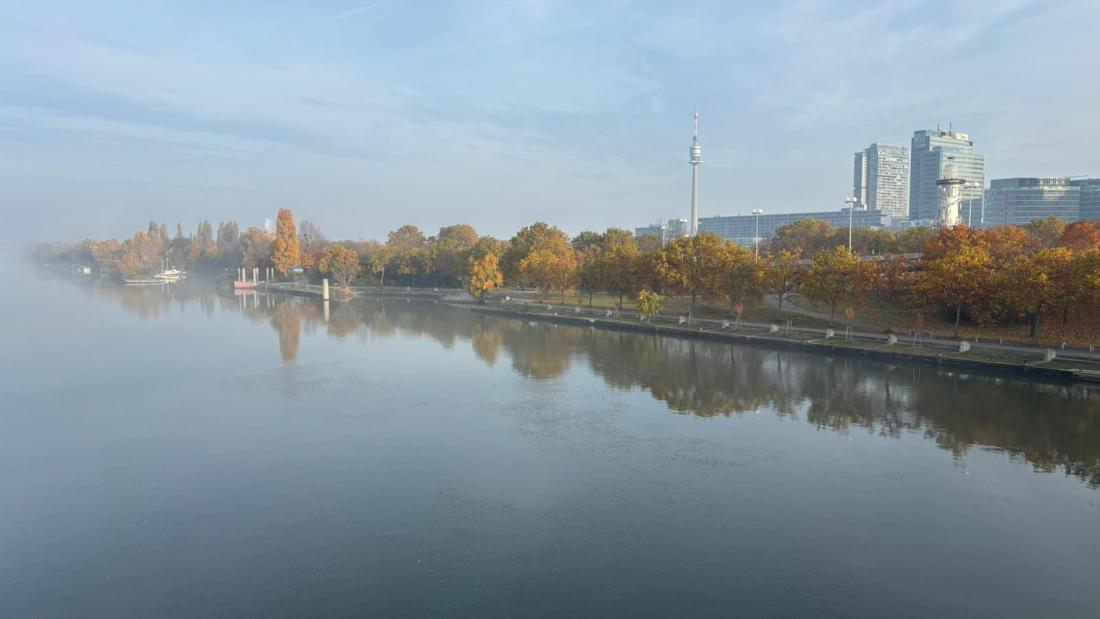Researchers from the School of Computer Science and Engineering, Bangor University, continued their strong presence at the prestigious IEEE VIS Conference series (the premier international forum for visualisation research), which was held in Vienna, Austria, 2-7 November 2025. IEEE VIS brings together leading researchers, practitioners, and educators in visualisation and visual analytics.
This year’s event featured an engaging programme of papers, workshops, tutorials, and art installations, including an ISOTYPE exhibition and the vibrant VIS Arts Program (VISAP). The conference opened with a keynote by Prof. Hans-Christian Hege and concluded with an inspiring capstone by Theo Deutinger. Theo is an Austrian architect, illustrator, academic, and co-founder of the Minus20degree art and architecture exhibition. He gave a thought-provoking talk showcased the power of visual storytelling through architecture and design.
The Bangor team enjoyed a productive and collaborative week, reconnecting with international colleagues, engaging in key workshops, and presenting research across several conference tracks. The weather in Vienna was beautifully warm, and the atmosphere throughout the conference, from the academic sessions to the evening arts events, reflected the strength and creativity of the global visualisation community and Bangor’s research. Prof Jonathan C. Roberts said: IEEE VIS continues to be the leading global venue for sharing ideas and shaping the future of visualisation research. It was fantastic to reconnect with long-standing collaborators and to see our students contributing so actively. Our presence at VIS not only strengthens Bangor’s international profile but also helps us feed cutting-edge research straight back into our teaching and supervision.
Prof Jonathan C. Roberts said:
IEEE VIS continues to be the leading global venue for sharing ideas and shaping the future of visualization research. It was fantastic to reconnect with long-standing collaborators and to see our students contributing so actively. Our presence at VIS not only strengthens Bangor’s international profile but also helps us feed cutting-edge research straight back into our teaching and supervision.
At the conference -- IEEE VIS 2025

High-Impact Publications
Professor Jonathan C. Roberts, Dr Panagiotis (Panos) Ritsos, Dr Peter Butcher along with PhD researchers Shannon Jones, Rhiannon Owen and Glory Ogbonda attended the event. Bangor researchers and collaborators achieved two full IEEE Transactions on Visualization and Computer Graphics (TVCG) publications (the leading Q1 journal and the main publication venue for IEEE VIS). These represent significant REF-eligible outputs and highlight the group's ongoing commitment to high-quality, impactful visualisation research.
Roberts, J. C.; Alnjar, H.; Owen, A.; and Ritsos, P. D. “Critical Design Strategy: a Method for Heuristically Evaluating Visualisation Designs”. Accepted for publication in IEEE Transactions on Visualization and Computer Graphics, 2026. Which was presented by Jonathan C. Roberts, and detailed on the CDS website.
Borowski, M.; Butcher, P. W. S.; Kristensen, J. B.; Petersen, J. O.; Ritsos, P. D.; Klokmose, C. N.; and Elmqvist, N. “DashSpace: A Live Collaborative Platform for Immersive and Ubiquitous Analytics”. IEEE Transactions on Visualization and Computer Graphics, 2025. https://doi.org/10.1109/TVCG.2025.3537679. (Presented by collaborators from Aarhus University; related to the accepted tutorial below.)
Tutorials and Workshops and Posters
The team’s participation extended beyond publications, reflecting Bangor's active role in shaping the broader VIS community through tutorials and workshops.
- IEEE VIS 2025 Tutorial Series. Borowski, M.; Butcher, P. W. S.; Jones, S.; Ritsos, P. D.; Klokmose, C. N.; and Elmqvist, N. Live Collaborative Immersive Analytics Development with DashSpace.
Facilitators included Shannon Jones (AIMLAC PhD student), Peter Butcher, and Panos Ritsos, in collaboration with Aarhus University, Denmark.
This tutorial showcased the DashSpace platform described in the TVCG paper above and connects directly to one of the group’s developing impact case studies on immersive and situated analytics.
The group presented two further workshop papers:
- Roberts, J. C.; Butcher, P. W. S.; and Ritsos, P. D. “From Data to Insight: Using Contextual Scenarios to Teach Critical Thinking in Data Visualisation”. IEEE VIS Workshop on Visualization Education, Literacy, and Activities (EduVis), 3 November 2025. Presented by Jonathan.
- Owen, R.; and Roberts, J. C. “Embedding Empathy into Visual Analytics: A Framework for Person-Centred Dementia Care”. IEEE VIS Workshop on Visual Analytics in Healthcare, 2 November 2025.
Both workshop papers were published in IEEE Xplore and exemplify Bangor’s interdisciplinary approach: from visualisation education to healthcare applications.
Dr Peter Butcher, who delivered the DashSpace tutorial and presented a live demonstration on stage during the conference, added:
The tutorial was a great success. We had participants using head-mounted displays and joining together in a shared 3D space to experience collaborative data analysis first-hand. It was brilliant to see researchers from across the world engaging with our platform and exploring how the Web can enable immersive analytics to support new ways of thinking, learning, and working.
Conference Posters
Ogbonda, G.; Nason, S.; Roberts, J. C.; and Butcher, P. W. S. “Explanatory Visualization with LLMs for Employment Law”. IEEE VIS 2025 Poster Proceedings. (Presented by Glory Ogbonda, in collaboration.)
Pete and Panos presenting DashSpace

Leadership Roles.
Prof. Jonathan C. Roberts served as co-chair of the IEEE VIS Education Workshop (EduVis), leading discussions on visualisation literacy and pedagogy. Organising the participants activity of sketching and exploring a Parallel Coordinated Plot application.
Prof. Jonathan C. Roberts, Dr Panos Ritsos, Dr Peter Butcher organised the “Inclusive Future Generation – AI & Visualization Skills Meetup”. The event meetup focused on diversity and inclusion in AI and visualisation. The session explored how visualisation can help broaden participation in AI by making complex concepts more accessible and engaging, while discussing strategies to widen access to AI-related education and career pathways across gender, ethnicity, disability, socioeconomic background, and discipline. Many discussions were had, over the conference, on accessibility and access to visualisation and AI.
Acknowledgements and Funding
The group gratefully acknowledges the generous support of several funding bodies:
- AIMLAC (Artificial Intelligence, Machine Learning, and Advanced Computing) UKRI Doctoral Training Programme, which funded PhD students Shannon, Rhiannon, and Glory.
- The Nuclear Futures Institute who predominantly funded Jonathan Roberts
EPSRC, which supported the attendance and contributions of Panos and Pete and supported the organisation of the AI Diversity meetup.
Looking Ahead
Bangor's Human-Centred Computing research group has maintained a strong and consistent presence at the IEEE VIS series over many years. This sustained engagement has fostered international collaborations and strengthened the University’s visibility in the visualisation and visual analytics community. Participation in IEEE VIS continues to play a strategic role in Bangor’s research profile, contributing to REF-quality outputs, impact case studies, and funded collaborations across Europe and beyond.
Dr Panagiotis (Panos) Ritsos commented:
Our presence at the top visualisation conference over the past years has provided us with plenty of opportunities to showcase our work to an audience that includes the top research groups on visualisation, in the world. It has also been instrumental in establishing strong collaborations with some of these groups, such as with Aarhus, Tufts, and Oxford Universities.
Shannon Jones, AIMLAC PhD student and DashSpace tutorial co-organiser, shared some final thoughts:
This was my first time attending IEEE VIS, and it was an incredible experience. Being part of the DashSpace tutorial and engaging directly with so many leading researchers really inspired me. It showed how welcoming and collaborative the visualisation community is, and it’s given me a lot of ideas to bring back into my PhD work.
At the conference






